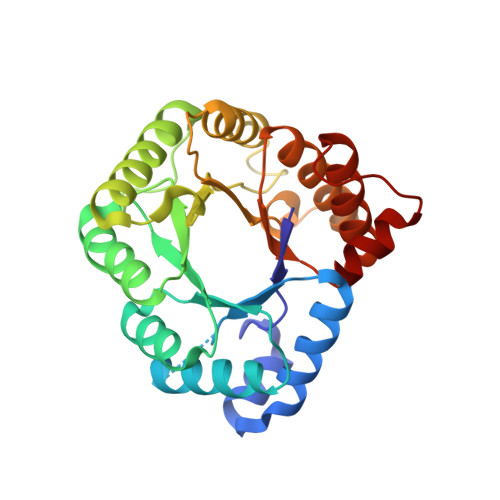Crystal structure of a methyltetrahydrofolate- and corrinoid-dependent methyltransferase.
Doukov, T., Seravalli, J., Stezowski, J.J., Ragsdale, S.W.(2000) Structure 8: 817-830
- PubMed: 10997901
- DOI: https://doi.org/10.1016/s0969-2126(00)00172-6
- Primary Citation of Related Structures:
1F6Y - PubMed Abstract:
Methyltetrahydrofolate, corrinoid iron-sulfur protein methyltransferase (MeTr), catalyzes a key step in the Wood-Ljungdahl pathway of carbon dioxide fixation. It transfers the N5-methyl group from methyltetrahydrofolate (CH3-H4folate) to a cob(I)amide center in another protein, the corrinoid iron-sulfur protein. MeTr is a member of a family of proteins that includes methionine synthase and methanogenic enzymes that activate the methyl group of methyltetra-hydromethano(or -sarcino)pterin. We report the first structure of a protein in this family. We determined the crystal structure of MeTr from Clostridium thermoaceticum at 2.2 A resolution using multiwavelength anomalous diffraction methods. The overall architecture presents a new functional class of the versatile triose phosphate isomerase (TIM) barrel fold. The MeTr tertiary structure is surprisingly similar to the crystal structures of dihydropteroate synthetases despite sharing less than 20% sequence identity. This homology permitted the methyl-H4folate binding site to be modeled. The model suggests extensive conservation of the pterin ring binding residues in the polar active sites of the methyltransferases and dihydropteroate synthetases. The most significant structural difference between these enzymes is in a loop structure above the active site. It is quite open in MeTr, where it can be modeled as the cobalamin binding site. The MeTr structure consists of a TIM barrel that embeds methyl-H4folate and cobamide. All related methyltransferases are predicted to fold into a similar TIM barrel pattern and have a similar pterin and cobamide binding site. The observed structure is consistent with either a 'front' (N5) or 'back' (C8a) side protonation of CH3-H4folate, a key step that enhances the electrophilic character of the methyl group, activating it for nucleophilic attack by Co(I).
Organizational Affiliation:
Department of Chemistry, University of Nebraska-Lincoln, 68503, USA.














